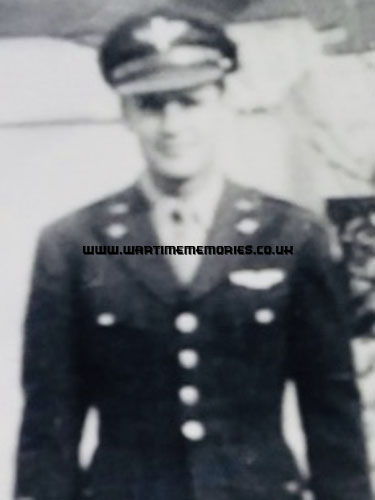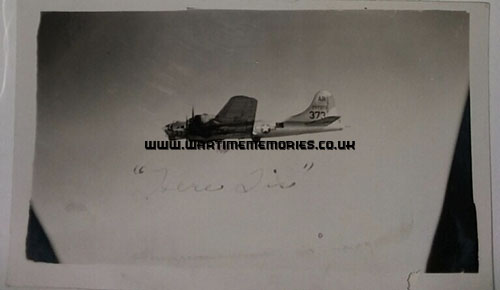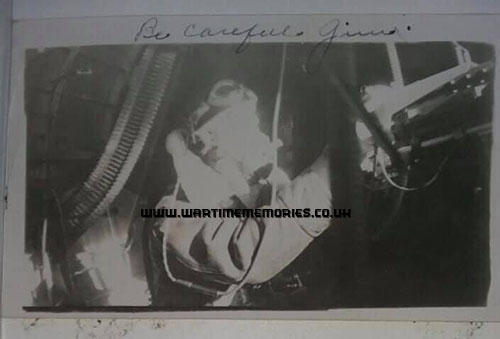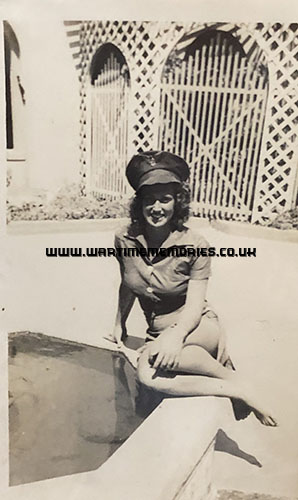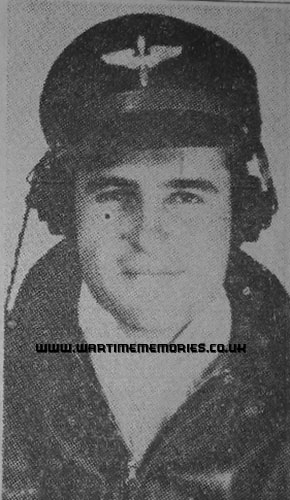F/O. James Nicholas Hentges
US Army Air Force 338th Bombardment Sqdn. 96th Bombardment Group
from:Santa Ana, Orange County, California USA
My grandfather Jim was a 2nd Lt./Flight Officer and bombardier in WWII. He was born on 9 December 1923 in LeMars, Iowa, and had two brothers and one sister. At some point during his childhood, his family to Orange County, California, where he graduated from Santa Ana High School.
He enlisted with the US Army Air Corps on 11 December 1942, just two days after his 18th birthday, in Santa Ana, California. He did his preliminary training at the Santa Ana Army Air Base. His brother, William Hentges, Jr. joined the Navy and was a Seaman, 1st Class, assigned to an Amphibious Branch and stationed somewhere in the South Pacific. I am told that my grandfather completed his bombardier training at Deming Army Air Field, in Deming, New Mexico and graduated with the Class of 44-08.
I was given two photos of my grandfather by my father and was told that the plane in the photos was a training aircraft assigned to the Ardmore Army Air Field, in Ardmore, Oklahoma, which was a four engine aircraft training base. Here is information I received about the aircraft that is reportedly the one in the photos my dad gave me (I don’t know if my grandfather was at any of the following locations during his training):
- Aircraft delivered to Cheyenne AAF, Wyoming on 23/02/1944
- To Great Falls AAB in Montana on 26/02/1944
- Back to Cheyenne on 02/03/1944
- To 222 BU Ardmore on 30/08/1944
- To 332 BU Ardmore on 19/06/1945
- To 370 BU Sheppard AFB in Texas on 19/06/1945
- Back to 332 BU in Ardmore on 26/02/1945
- Sold to the Reconstruction Finance Corp. on 24/08/1945 and scrapped at Walnut Ridge AFB, Arkansas
My grandfather told my dad that they flew their planes to England, stopping in Greenland to re-fuel. He said that was the quickest route to get there. On 2 October 1944, he was assigned to the 338th Bombardment Squadron, 96th Bombardment Group (Heavy), 3rd Bombardment Division, 45th Combat Bomb Wing, 8th Air Force and stationed at Snetterton Heath Air Field (AAF Stn: 138-ETG, RCL: BX-A), known as the ‘Snetterton Falcons’ and home to everyone’s favorite mascot, Lady Moe the donkey.
I have been unable to locate information on his first 6 missions. But I do have some information on his 7th mission, which was his last. He was the bombardier on B-17G-90-BO, a Boeing B-17 Flying Fortress (airplane #43-38644, nicknamed “Green Weenie”).
The winter of 1944-45 was the coldest on record in 54 years. Their target on 5 December 1944 was an ordnance plant located in Berlin, Germany. The weather was not good. With low clouds making visibility nearly impossible, and strong, changing wind gusts, it would be dangerous and difficult. Dangerous because they needed to fly lower and get under the clouds to get a good visual of their target, and, with the changing wind and weather, difficult to calculate the precise time to drop the bomb load on the specified target.
Don’t forget the hours-long flight, the tiny, cramped spaces, and crews battling exhaustion and fatigue and having to wear electric suits that at times would malfunction and catch fire. Heated gloves, if removed to help a crewman in trouble or to pull a ripcord, could mean the loss of fingers due to frostbite. And hard, heavy metal helmets that moved all around and were a struggle to keep on, and that were supposed to help your protect your head in case a bomb hits and blasts apart the aircraft, but in reality were more like a big bullet because when the blast hit, the helmet flew off your head and shot through the aircraft, leaving nothing in its wake.
Don’t forget the very important, big, bulky oxygen masks. The warplanes were not like the modern ones of today. They weren’t equipped with pressurized cabins. Those masks were a lifeline, and one little leak or a few too many minutes trying to outrun the enemy’s fire could cause you not to have enough oxygen left to complete your mission and get back to base. Dizziness, confusion, panic, and paranoia would then set in - almost always a death sentence for all aboard.
No wonder the loss of life was so great. The odds kept stacking against them. With each new mission, the odds of being able to complete the mission and make it back to base uninjured and alive became slimmer.
Based on eyewitness accounts and crew statements, my grandfather’s flight was at about 28,000 feet over their target when they started taking on lots of flak. I assume that most or all of their bomb-load was had already been dropped because somehow they were hit by flak that came in through the open bomb-bay doors and started a fire. I read that if planes were hit with full loads they would explode upon being struck, with no chance of survival. My grandfather told my dad that flak shrapnel went straight through the plane. It caused a small fire, but they quickly put it out.
But by then they were also taking on enemy fire from three German ME-109s. That’s when they got hit. They lost one engine, then two. My grandfather said they were down to one engine when they bailed out. One eyewitness stated that my grandfather’s aircraft was able to shoot down one of the ME-109s before he lost sight of the plane and its crew. Eyewitness and crew reports agree that when first hit, the aircraft appeared to be out of control. But then the pilot, David Monroe, managed somehow to regain control of the aircraft and took it straight up into the thick, dark clouds. The same clouds that once caused them danger and difficulty now provided them safety and protection from the remaining two ME-109s.
All ten crew members of my grandfather’s B-17 were able to bail out and land safely, with no one suffering from any major injuries. When asked months later, one crewman stated that the Green Weenie’s crash site was about 30 miles from Berlin, Germany. They were quickly captured by German soldiers southeast of Parchim, Germany, and taken to a POW camp called Stalag Luft 1- North 3, in Barth, Germany. Four days later, on 9 December 1944, my grandfather spent his 21st birthday (most likely in solitary confinement) awaiting interrogation by the Germans, as was customary for new prisoners. I have read that they could be in the interrogation rooms for a week to a month, or for some even longer. The Germans would try just about anything to get the men to talk.
I recently read about the conditions of Stalag Luft 1, where my grandfather and his crew were held. There were only two latrines for 2,500 men. Toward the end of the war, they received only one bowl of soup (that was mostly water) and a piece of bread per day. Bunks, if they can be called that, were so low that you couldn’t sit up on them and were stacked four high. They were each furnished with a straw-stuffed bedroll. Maybe there was a thin blanket, but never a pillow. I read that POWs called them mortuary slabs, because that’s about what they looked like.
My grandfather was one of the lucky ones since he was assigned to the officers’ section, the ‘better’ section. I can’t even begin to think what the other sections must have been like. The American commander of their barracks in the North 3 section was WWII fighter ace, Francis ‘Gabby’ Gabrowski. My grandfather told my dad he was in the same barracks with Gabby and that he was loud and arrogant as all hell!
They were finally liberated by the Russians and released on 30 April 1945. He and his crew touched US soil on 2 June 1945. Most of them, like my grandfather, had jobs to do, families to raise, and just didn’t speak much of their time in the war.
My grandpa married my grandmother, Helen Louise (Mitchell-St. Clair) Hentges in 1956. From a previous marriage, she had a son, my father (Michael St. Clair, born July 4, 1947), whom my grandfather raised as his own son. My dad never really knew his real dad, (Walter James St. Clair, also a WWII US Army Air Force veteran), because he and my grandma divorced soon after my dad was born. By the time I tracked him down, he had already passed away.
My dad is an Air Force veteran as well, and served in Vietnam. I was born at Eglin AFB in Okaloosa County, Florida. Three weeks after my birth, my mom brought us to California, where my dad joined us after being discharged from the service.
My grandpa Hentges was a wonderful grandfather! He took us fishing, horseback riding, took us to the pizza parlor and gave us pennies to ride the mechanical horse! He even met us drive his work van (well, we got to steer the van while he worked the pedals, but to us we were driving)! He would also take us to lunch at the Chino Airport in California, where we’d watch the planes land and take off. It was so much fun!
My father also took us to Chino Airport, and to the Planes of Fame Museum next door to see the B-17 ‘Piccadilly Lilly II’, the big plane like the one our grandpa flew. I have been able to share the same experience with my own kids. We now have a third-generation picture of my kids in front of the same B-17, ‘Piccadilly Lilly II’. My son liked the museum so much he asked to go again, and we took a group of his friends there for his birthday, many moons ago!
My grandfather passed away on Father’s Day, 15 June 1980. I was only 8 years old. We were very close. I didn’t understand. I never had someone close to me die before. It’s hard to understand that there will be no more hugs, or fun trips, or even just the sound of his voice. I’ll never get to hear his story, in his own words. His story IS history. I want to give him and all the other men and women who served the honor, the respect, and the chance to perhaps find closure, to heal old wounds, or to find answers to the unknown fate of some of the others who served.
To my grandfather James N. Hentges and ALL veterans:
- Thank you for your service, your love, your honor and dedication to preserving the freedoms of our great countries. May God watch over you and guide you, and may He bless each and every one of you.
- To those who gave all and made the ultimate sacrifice, please know we have not forgotten. We will continue to preserve history and share in the memories of your lives with future generations to come. Thank you for your service. May you forever rest in peace.
